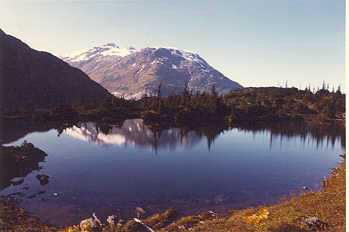Early Mines

Indian Mines
Photo - Indian Lake located just past Priemer Mines
Currently the Indian mine is held by New Indian Mines Ltd., through its subsidiary, Mammoth Indian Mines Limited, which controls 66 claims in the Cascade Creek section of the Salmon River district. The Indian group (original Portland No. 1 and Portland No. 2) claims were located in 1910 to investigate surface mineralization discovered on Indian Ridge between Noname Lake and Indian Lake.
Initial development consisted of surface trenching by Indian Mines Ltd. The property was reorganized in 1923 under Indian Mines Corporation, Ltd., which performed the bulk of the underground development between 1923 and December, 1925, when operations ceased. In 1946, Indian Mines (1946), Ltd. acquired the holdings of Indian Mines Corporation, Ltd. and rehabilitated the camp in 1947.
The buildings were caved by heavy snow during the 1947/48 winter and some of the buildings were repaired in 1948. Subsequently the Silbak Premier company made a working agreement with the owners and constructed a 2-mile aerial tram-line from the Indian mine to Premier, which was completed in 1951.
The bulk of the ore was produced from the Indian in 1952 and concentrated at the Premier mill. In 1953 the operation was closed down nominally because of low lead-zinc prices. In 1962 a geological examination of about 90 claims then controlled by New Indian Mines Ltd. was undertaken by a field crew directed by R. V. Best. In 1963 the company drilled four holes to intersect a narrow northwest-trending zone on the Missing Link and Payroll No. 4 claims and re-sampled eight pits and trenches.
No active exploration has developed since that time, but access to the property which formerly presented severe problems have been completely overcome by the construction of the Granduc road which passes within 2,000 feet of the main adits.
Geology
The property lies astride the irregular contact between the border phase of the Texas Creek granodiorite and altered cataclasites derived from conglomeratic members of the local Hazelton assemblage. In the past the local petrology has been poorly understood because of poor outcrop, fairly heavy undergrowth, difficult access, and, most significantly, because of the use of old Premier mine rock terminology.
Both the intrusive and country rocks in which the deposit lies have undergone metamorphism or metasomatism, as well as faulting and dyke intrusions. Lenticular remnants of country rock in the mine area include green volcanic conglomerate and thinly striped tuffs and siltstones, as well as their deformed (cataclastic) equivalents.
These country rocks have been largely altered by granitization to produce an irregular pseudoporphyry resembling the Premier Porphyry. These metasomatic rocks are marked by a light- to brownish-green colour, with random coarse orthoclase and disseminated medium-grained, brown homblende porphyroblasts.
The actual igneous contact is fairly clear in the road cuts but becomes somewhat diffuse toward the mine proper, where silicification becomes dominant. The granitized and silicified sections are gradational eastward into the less altered, variably schistose, light-green cataclasites of the Cascade Creek section.
In the mine section, evidence of replacement of metasomatic orthoclase by quartz as part of the ground preparation process can be readily seen. This process also involved pyritization, carbonatization, and K-metasomatism, which produced irregular sericitic zones in the pseudoporphyry and cataclasites.
Subsequent to metasomatism, steep northerly fractures developed which served as depositional sites for extensive quartz fissure-vein deposits. These were later cut by members of the Premier dyke swarm and again by lamprophyre dykes. As at Big Missouri and Premier, a Bowser capping of the deformed Hazelton assemblage can be projected on the basis of existing remnants and their structure.
NEXT LAKESHORE PROPERTY